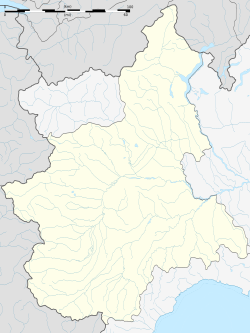Villar San Costanzo is a comune (municipality) in the Province of Cuneo in the Italian region Piedmont, located about 70 kilometres (43 mi) southwest of Turin and about 15 kilometres (9 mi) northwest of Cuneo. As of 31 August 2007, it had a population of 1,474 and an area of 19.5 square kilometres (7.5 sq mi).[3]
Villar San Costanzo
Lo Vilar | |
|---|---|
| Comune di Villar San Costanzo | |
| Coordinates: 44°29′N 7°23′E / 44.483°N 7.383°E | |
| Country | Italy |
| Region | Piedmont |
| Province | Province of Cuneo (CN) |
| Frazioni | Morra, Artesio, Rivoira |
| Area | |
• Total | 19.5 km2 (7.5 sq mi) |
| Elevation | 605 m (1,985 ft) |
| Population (Aug. 2007)[2] | |
• Total | 1,474 |
| • Density | 76/km2 (200/sq mi) |
| Time zone | UTC+1 (CET) |
| • Summer (DST) | UTC+2 (CEST) |
| Postal code | 12020 |
| Dialing code | 0171 |
| Patron saint | Constantius |
| Website | Official website |
Sights to see in Villar San Costanzo include the natural reserve known as Ciciu del Villar; the Abbey built in early 700 AD; and the very ancient church of San Costanzo al Monte, a stunning example of Romanesque-Gothic architecture dating back to the 12th century. The town takes its name from Saint Constantius, a soldier of the Theban Legion, who is said to have been beheaded at the spot now occupied by the sanctuary of San Costanzo al Monte.[4] The local geologic formation known as Ciciu del Villar, which are columns formed by natural erosion, was connected with Constantius' legend: the stones are said to be the Roman soldiers sent to kill him, who were miraculously petrified before they could harm the saint.[4]
Villar San Costanzo borders the following municipalities: Busca, Dronero and Roccabruna.
-
Santuario di San Costanzo al Monte
-
Santuario di San Costanzo al Monte
-
Ciciu del Villar
Demographic evolution
edit
Twin towns — sister cities
editVillar San Costanzo is twinned with:
- Rosières, Haute-Loire, France
References
edit- ^ "Superficie di Comuni Province e Regioni italiane al 9 ottobre 2011". Italian National Institute of Statistics. Retrieved 16 March 2019.
- ^ "Popolazione Residente al 1° Gennaio 2018". Italian National Institute of Statistics. Retrieved 16 March 2019.
- ^ All demographics and other statistics: Italian statistical institute Istat.
- ^ a b Arduino, Fabio (October 27, 2005). "San Costanzo e compagni". Santi e Beati. Retrieved December 28, 2008.
External links
edit





